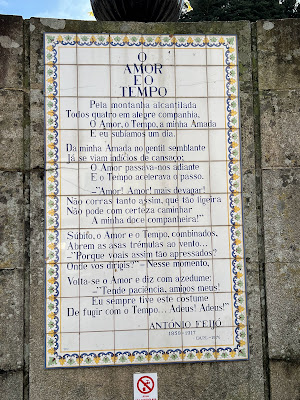A statue of Dona Teresa, once the Queen of Portugal, who granted the charter to Ponte De Lima in 1125. The statue shows her holding out a document, which is probably the charter.
The Romans eventually, around 1 A.D., constructed a bridge across the Lima River, and that bridge was later renovated and improved during the 14th century.
More photos of the bridge.
Across from the shrine and pilgrim statue is the Church of Santo António da Torre Vellha ("Old Tower"), which was constructed in the 19th century.
Behind the church is the small Chapel of Anjo da Guarda ("Guardian Angel"), which may date to the 13th century.
This tower had an intriguing azulejos mosaic, which was created by Jorge Colaço, a famed Portuguese painter. It's caption states, "Cabras São, Senhor," which roughly translates as "They are goats, Sir." The mosaic depicts King Afonso Henriques, around 1140 AD, on a hunt. While enjoying dinner at the Chaplain of the Nuns of the Monastery of Vitorino das Donas, the group worried about great sounds and lots of dust in the distance, fearing it might be an enemy army. When scouts checked out the situation, they returned to King Afonso and told him that "They are goats, sir."
This is O Amor Eo Tempo, a famous poem about love and time by poet António Feijó, who was from Ponte de Lima.
Bronze statues, ''Alegoria as Feiras novas e no folclore'' (''Allegory to the New Fairs and Folklore'') created in 2009 by sculptor Salvador Vieira (1937-2017).
This bronze bull statue commemorates the traditional Vaca da Cordas, whose origins are lost in the ancient past. It takes place on the day before the Feast of Corpus Christi, and a bull is led through the city on several ropes. It's still dangerous and some people who get too close to the bull have been injured. But, it's a joyous occasion, with much festivities.
Another mosaic of azulejos, depicting King João ("John") IV, the Restorer, who reigned from 1640-1656.
Photos from inside the church. Such intricate and beautiful artwork. This would be common in a number of the churches we visited in northern Portugal. The dedication, skill and passion of the artists is amazing.
And now, just a number of other photos of Ponte de Lima.
So rare to see a phone booth any longer in the U.S.
So rare to see a phone booth any longer in the U.S.
Ponte de Lima was a charming and beautiful town, and I only scratched the surface of the sights. I highly recommend you visit if you visit the Vinho Verde region.










































No comments:
Post a Comment